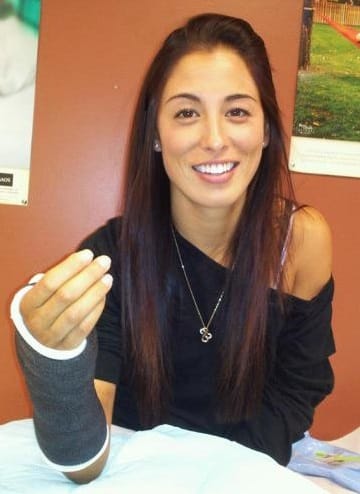
This is article six of Part One of the “Conquering Debt Series.” Read article five of Part One here.
Paying for medical or dental care may be hard when you are experiencing financial problems.
Trust me, I know! Back in 2011, I was in a pretty severe motorcycle accident. I ended up in the hospital for three days with a shattered wrist, a fractured pelvic bone, and two black eyes.
I had a major surgery that left me with a metal plate and six screws in my right wrist. That doesn't include the x-rays, the blood tests, or the medication they gave to me while I was there.
To make things worse, I was working a minimum wage job at the time and couldn't afford health care.
A couple of days after getting out of the hospital, the medical bills started rolling in. One after another. Bills were coming for lab tests, hospital food, anesthesiology, physicians, medication, and everywhere in between. To make things more confusing, they were coming from different companies, not just the hospital where I stayed.
When I was done totaling the numbers, my accident cost me a little over $49,000! None of which was covered by medical insurance.
I ended up calling the hospital in desperation. I explained my situation, and they suggested I fill out a financial hardship to see if I could get my bill reduced.

The hospital granted me partial financial hardship, and I ended up owing a total of $10,000. It took me a little over three years, and four different payment plans to pay it off.
I guess you could say I take medical insurance a little more seriously now.
But what do you when you are already struggling, and can't afford the medical coverage that you need?
Here is some advice on how to obtain low-cost or free care.
HEALTH COVERAGE AFTER LOSING A JOB
Most people think about preventative care when they think about medical coverage. Are routine doctor visits or dental visits covered 100%? How big is my deductible? How much do I have to pay out-of-pocket? What is my copay? These are just some of the more common questions people think about when they are looking at medical insurance.
But what about the circumstances that aren't common, like large unplanned medical expenses?
In 2014, it became a lot easier to access affordable health insurance, either through Medicaid or subsidized insurance exchange. There are also ways to access health care, even if you don't qualify for federally-funded programs.
One example of this is called COBRA insurance. If you worked for a company that had 20 or more employees and you were covered by your employer's health insurance, you might be able to keep your insurance, although you must pay the premiums.
Your employer must notify the insurance company within 30 days after you lose your job, and the company then has 14 days to contact you. You will then have 60 days to decide whether to pay the premium to keep the coverage.
If you can afford to pay the premium to keep your existing coverage, it might make sense to do so if you do not qualify for Medicaid or an Exchange plan. This is especially important if someone in your family has an existing medical condition.
SUBSIDIZED EXCHANGE COVERAGE
Most people are eligible to purchase health insurance in a marketplace called the Exchange. Subsidized Health Coverage is available at reduced or no cost for people with incomes below certain levels.
How do you know if you qualify?
- If your family has income between 100% and 400% of the federal poverty level, you may receive tax credits to make health insurance more affordable.
- If your family has income below 400% of the poverty line, and if you are already enrolled in an Exchange plan, you can also receive subsidies to help pay for out-of-pocket health care costs.
- Your household income must be below 138% of the federal poverty level to qualify.
The amount of both of these subsidies varies with your income. The lower your income, the less you have to pay.
MEDICAID
Beginning in 2014, you can apply for both subsidized Exchange coverage and Medicaid coverage at the same time. Medicaid is a program that provides low-cost health insurance to some low-income people.
Eligibility varies from state to state and depends on family income and resources. Sometimes you can get Medicaid for your children, even if YOU don't qualify.
Like regular health insurance, Medicaid pays the physician, pharmacist, and any other service provider directly. Many states have a co-payment system which the Medicaid patient pays a small amount, usually only a few dollars, towards the service.
It's important to point out that Medicaid coverage must include specific mandatory services, like hospital care and doctor's visits. If you are older and have low-income, Medicaid generally covers long-term care such as nursing facilities.
The online form for Medicaid is the simplest way to apply for benefits, and submitting the completed application happens within minutes.
All Washington residents can apply for institutional Medicaid through wahealthplanfinder.org. If you want to apply online for cash, basic food benefits, and long-term care, go to Washington Connections.
MEDICARE
If you are over 65, make sure you are getting available Medicare benefits. If payment of a claim is denied, make sure to find out why.
Medicare Part D is a prescription drug program for seniors that went into effect in 2006. It is a voluntary program that allows seniors to shop around for a prescription drug provider among a number of different private insurance companies.
If you are having financial troubles, selecting a plan that is favorable for you could save you a lot of money on drug costs. It is essential to shop around and call providers to find out about costs and about any restrictions on access to the prescription drugs you might need.
There are also some programs that provide supplements to Part D coverage.
For more information, check out the federal government's website on Medicare. The National Senior Citizen Law Center (Phone: 202-289-6976) and the Center for Medicare Advocacy (Phone: 860-456-7790) are both excellent resources for more information on Medicare.
CHILDREN'S HEALTH INSURANCE PROGRAM (CHIP)
CHIP is a program that provides health insurance to children in families with incomes that are slightly above Medicaid limits.
Each state has its own rules. You can apply any time of year, and you won't have to buy a separate insurance plan to cover them.
There are currently two ways to apply for CHIP:
1. Call 1-800-318-2596 (TTY: 1-855-889-4325)
2. Fill out an application through the Health Insurance Marketplace. If they determine that anyone in your household qualifies for Medicaid or CHIP, they will send your information to your state agency. They will then contact you about enrollment.
Create an account or log in to an existing account to get started.
The costs are different in each state, but you won't have to pay more than 5% of your family's income for the year.
IF YOU ARE DEALING WITH MEDICAL DEBT
As I found out, medical debt can be overwhelming if you don't have coverage and it can become an enormous expense.
There are different strategies that you can use to help with the burden of medical debt. Before looking at any of the strategies listed below, remember that medical bills are unsecured debts. You should review advice in Article One of Part One of the Conquering Debt Series about what bills you should pay first.
Unpaid doctor and hospital bills should not prevent you from getting free or low-cost medical and dental care.Click To TweetINSURANCE RIGHTS
Some providers end up billing patients directly instead of, or in addition to, Medicaid or Medicare. Unless it involves co-payments or other amounts permitted under those programs, this practice (known as “balance billing”) is NOT allowed and is prohibited.
If you are covered by insurance, Medicare, or Medicaid, make sure the hospital or medical provider sent your bill to the insurance company to be paid and used your correct information.
Make sure to look at your document called “Explanation of Benefits” that your insurer sends you. It will include the reason why your insurer denied payment and information about your appeal rights.
FINANCIAL ASSISTANCE/CHARITY CARE
Nonprofit hospitals have a duty because of their tax-exempt status to provide a certain amount of charity care or financial assistance to low-income patients. This was the case with my motorcycle accident.
The Affordable Care Act requires nonprofit hospitals to provide low-income patients an application for financial assistance. You should ALWAYS apply for charity care or financial assistance to be applied to your bill.
NEGOTIATE
Negotiating can be an effective strategy in dealing with medical debt. A request to a medical provider to reduce the amount of your bill can lead to surprisingly good results.
You might want to ask for a payment plan. Make sure to ask for:
- both a reduction or discount on the bill and payment method
- any payment plan to be documented in writing
- No or minimal interest for your payment plan
If you have debt or if you are having financial troubles, it's vital that you check out your options for reduced or free health coverage. If you find yourself in my situation and accumulate medical debt and are struggling to find ways to pay it off, use the strategies above to see if it can be reduced. Always ask about payment plans, which can be negotiated for as little as a few dollars a month.
Were you able to get your medical bills reduced? Let me know how you did it in the comments below!

